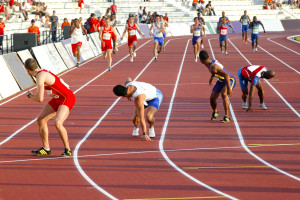 Last August we all watched in awe at the XXXI Olympiad in Rio. As Katie Ledecky once again broke the world record for the 800 meter freestyle, we couldn’t help but wonder: how do we keep getting faster? 100 years ago, the world record for women’s 800 meter freestyle was 13 minutes. Last August, Katie Ledecky shaved about 5 minutes off of that time.
Last August we all watched in awe at the XXXI Olympiad in Rio. As Katie Ledecky once again broke the world record for the 800 meter freestyle, we couldn’t help but wonder: how do we keep getting faster? 100 years ago, the world record for women’s 800 meter freestyle was 13 minutes. Last August, Katie Ledecky shaved about 5 minutes off of that time.
In his TED talk, David Epstein shed a lot of light on this phenomenon. He argued that it’s not humans that are evolving. Rather, it’s the games themselves.
Huge Leaps Forward
Epstein shares a graph that illustrates huge leaps and bounds in swim times throughout the years. He correlated those to new developments in methodology, tech, and engineering. For example, when the flip turn was incorporated into swim races, it cut off a significant amount of time in the world record. Additionally, new developments in swimwear allow swimmers to cut through the water and move more effectively.
Wider Access Makes the Field More Competitive
One major reason for the growth and development of athletes in general is the way that access to the sporting world has grown hugely in the last hundred years. Today, athletes are professionals, not amateurs who train in their free time. Today, access to athletics is available for more women, for more races, and for more socioeconomic groups. Between that and the growing population, we have a much larger group from which to choose our best and brightest athletes. After all, who’s better: the best of 100 people, or the best of 5,000?
The Rio games this year illustrated this development dramatically with our American women. They absolutely dominated, and many attribute that to the wider access that women have to sports over other countries and locations.
Sports Psychology Teaches Us To Test the Boundaries
The final big reason for the constant improvement of our athletes is harder to put your finger on. It has to do with the mental limitations that we put on ourselves. This was most dramatically and memorably illustrated by the shattering of the four minute mile. In 1945, the world record for running a mile was held by Gunder Hagg, who completed it in 4 minutes and 1.3 seconds. For almost 10 years, it was believed that humans had gone as far as they could go; there was no way to conquer a mile in less than four minutes.
It could be due to this psychological barrier that so many people made it their goal to defeat the four minute mile. In 1954, Roger Bannister completed a mile in 3 minutes and 59.4 seconds. Only two months later, another athlete broke this barrier, Australian John Landy. Since then, the four minute mile is the standard for world-class runners, although it’s left the common vernacular since sports shifted to the metric system.
However, this incident illustrates an interesting point: sometimes, the biggest barrier to achievement is psychological. Sports psychologists work with athletes to help them push the boundaries of the human body. Any marathon runner will say that the race is just as much a mental feat as a physical one.
Exercise Science
For those fascinated (as we are) with the amazing feats of the human body, as demonstrated through Olympic athleticism, Exercise Science may be an optimal field of study to pursue. To get you on the right track, Carone Learning’s Exercise Science course covers aspects from the physiology of body systems and analyzing biomechanics to sports psychology and nutrition. Learn more today!



